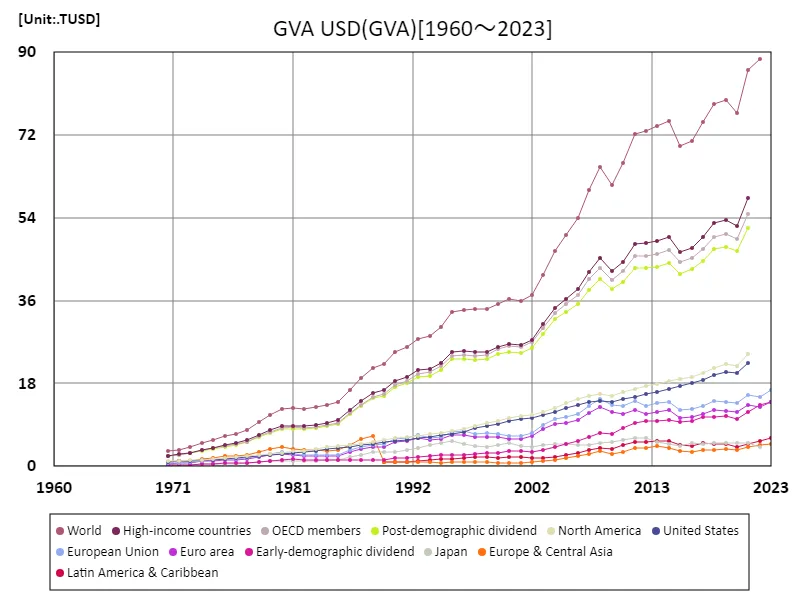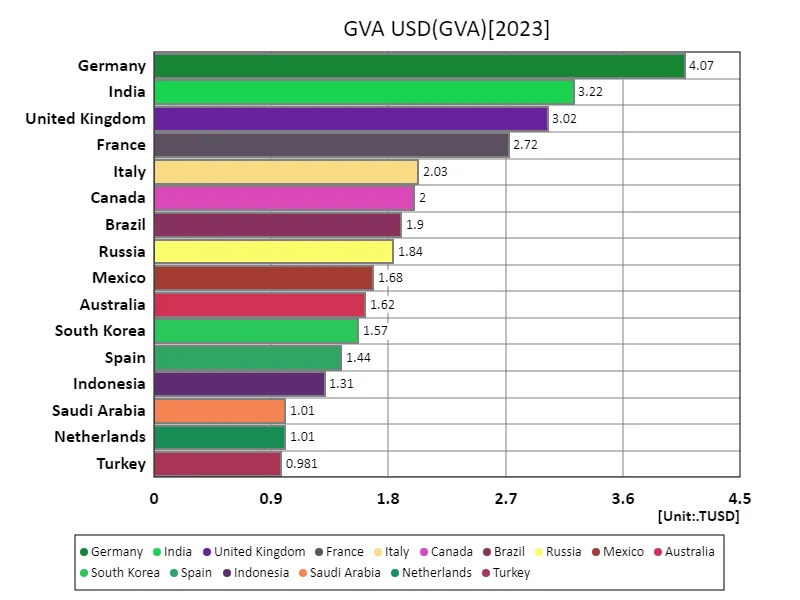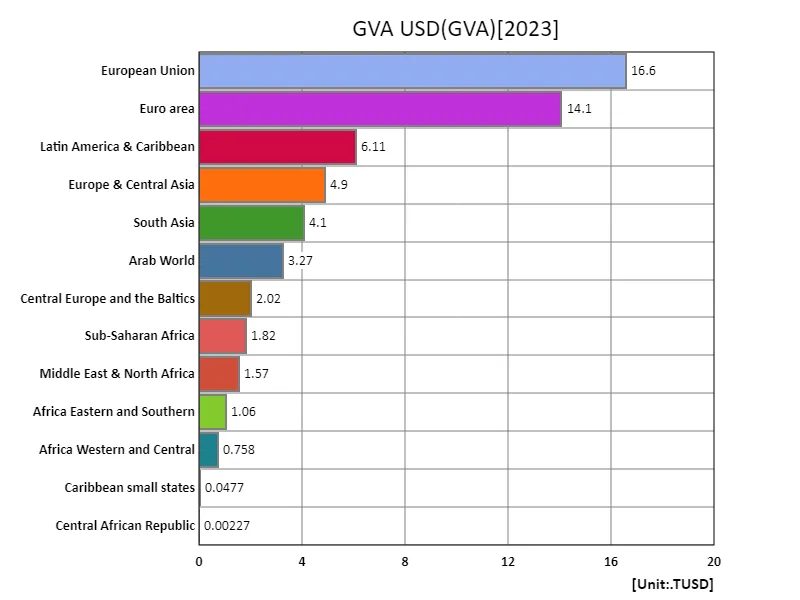Abstract
According to 2023 data, the European Union’s (EU) production value added (GVA) will reach US$16.6 trillion, making it the largest in the world. The large size of the EU’s economy is due to the fact that it includes many major developed economies. The region is dominated by large economies such as Germany, France and Italy, and is characterised by strong manufacturing and service sectors. Over the past few decades, the EU has focused on upgrading its manufacturing and expanding its services sector. This has led to a steady increase in value added in the economy. However, in recent years, the country has been affected by geopolitical risks, fluctuations in energy prices, Brexit, and other factors, and economic stability is a challenge. In contrast, the United States has a similarly high GVA but, unlike the EU, has a more innovation and technology-driven economic growth. China also continues to grow rapidly, which will have a major impact on future fluctuations in added value. Overall, the EU’s economy remains strong but it needs to adapt to international competition and internal changes.
Gva, US dollars
The added value of agriculture, forestry and fisheries has grown significantly over the past few decades. From the 1960s to 2023, the sector has expanded rapidly and become a significant economic activity, especially in developing countries. This has contributed to increased food production and job creation in rural areas, and global agriculture, forestry and fisheries value added could reach an all-time high of US$4.35 trillion by 2023. This growth is the result of technological innovation, improved agricultural productivity and expanding markets, with agricultural policies and international trade also playing a major role. At the same time, risks such as climate change and weather abnormalities are increasing, making sustainable agriculture even more important. Going forward, there will be a demand for efforts to balance environmental considerations with improved productivity. Agriculture, forestry and fisheries continue to play a vital role in the global economy and are key pillars towards sustainable development.


The maximum is the latest one, 88.6TUSD of World
Gva, US Dollars (Worldwide)
The economic importance of agriculture, forestry and fisheries has increased significantly over the past decades. In particular, in the case of China, the sector grew rapidly between 1960 and 2023, reaching an all-time high of US$1.31 trillion in value added in 2022. China’s agriculture, forestry and fisheries are important pillars of the domestic economy, making significant contributions to increasing food production and creating jobs. This growth has been underpinned by technological innovation, agricultural modernization and market expansion. At the same time, environmental impacts and sustainability issues are also increasing, and there is a need to balance the efficient use of resources with environmental protection. The added value of China’s agriculture, forestry and fisheries is now 96.8% of its peak, and the economy is diversifying and adopting new technologies. In the future, key challenges will be to build sustainable agricultural systems and strengthen competitiveness in international markets.


The maximum is the latest one, 22.5TUSD of United States
Gva, US Dollars (Worldwide, latest year)
According to 2023 data, Germany recorded US$4.07 trillion in production value added (GVA), making it the largest in the world. Germany’s economy has a strong manufacturing sector, particularly the automotive and machinery industries, with advanced technology and efficiency being major drivers of added value. This helps Germany maintain its economic leadership within the European Union. Total global GVA in 2023 will be US$46.5 trillion, compared with an average of US$312 billion. The data shows the strength of developed economies along with the growing size of the global economy, but also reflects growth in emerging countries. Over the past few decades, technological innovation and globalization have driven economic growth, particularly in the digital economy and the service sector. Overall, the increase in GVA reflects the growing size of the global economy and the economic dominance of certain countries, but regional imbalances and economic fluctuations will be challenges in the future.


The maximum is 4.07TUSD of Germany, the average is 313GUSD, and the total is 46.4TUSD
Gva, US dollars (region, latest year)
The European Union recorded the highest global agriculture, forestry and fisheries GVA in 2023 at US$16.6 trillion. This demonstrates the importance and quality of agricultural production within the EU. The global average GVA is US$4.33 trillion, reflecting the huge impact agriculture has on the global economy. There are large differences between developing and developed countries in terms of GVA for agriculture, forestry and fisheries. It remains an important economic activity and a major source of employment in developing countries, while developed countries are seeing a push for technological innovation and sustainable agriculture. Sustainable development and increased productivity are key challenges for this sector, which is particularly vulnerable to climate change and natural disasters. Overall, agriculture, forestry and fisheries play an important role in the global economy, but their influence and speed of development vary depending on regional conditions and policies. Going forward, the adoption of technology and the promotion of sustainable agriculture will be essential to the growth and stability of the sector.


The maximum is 16.6TUSD of European Union, the average is 4.33TUSD, and the total is 56.3TUSD



Comments